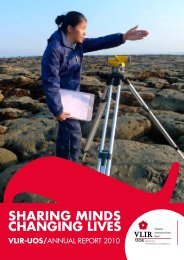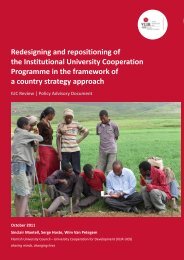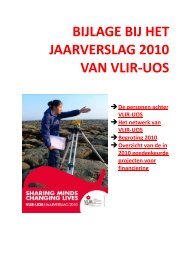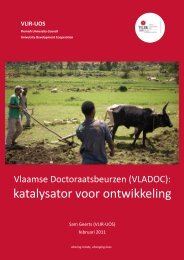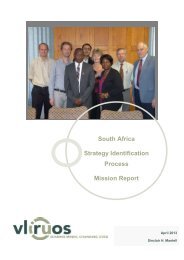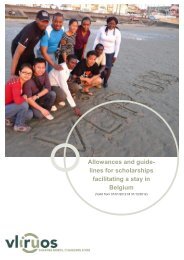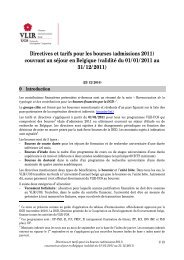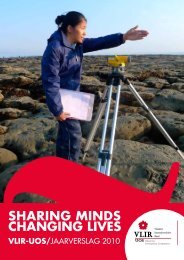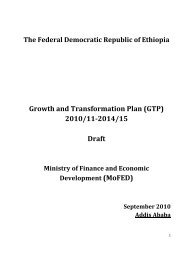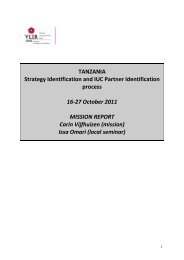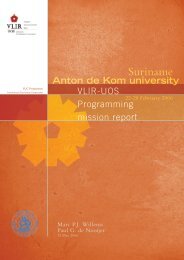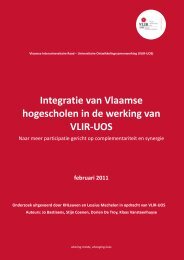Education Sector Development Program - VLIR-UOS
Education Sector Development Program - VLIR-UOS
Education Sector Development Program - VLIR-UOS
You also want an ePaper? Increase the reach of your titles
YUMPU automatically turns print PDFs into web optimized ePapers that Google loves.
<strong>Education</strong> <strong>Sector</strong> <strong>Development</strong> <strong>Program</strong> IV<br />
Component 3 Access of girls to science and<br />
TVET increased, with emphasis on areas that are<br />
traditionally considered men’s<br />
Increase the number of TVET centers including at<br />
locations that can be reached by female students<br />
Maintain preferential access for female students<br />
Provide tutorial support for beneficiaries of the<br />
preferential access system<br />
Increase the awareness and confidence of female<br />
students.<br />
Component 4 Literacy level of women increased<br />
through greater participation in functional adult<br />
literacy<br />
Strengthen the awareness of personnel at federal<br />
and regional levels involved in Adult <strong>Education</strong> and<br />
in FAL on specific situation and needs of women<br />
Strengthen the awareness of personnel at woreda<br />
and kebele levels involved in Adult <strong>Education</strong> and<br />
in FAL on specific situation and needs of women<br />
Integrate FAL with focus on females in activities of<br />
Woreda and Kebele <strong>Education</strong> and Training Boards<br />
Open more FAL centers to increase access for<br />
women<br />
Ensure that proportional number of men and<br />
women participate in literacy programs<br />
Component 5 Number of female administrators,<br />
supervisors and director increased<br />
Introduce affirmative action to enable female<br />
teachers secure administrative positions<br />
Organize training on leadership, assertiveness, and<br />
other skills to female administrators and teachers<br />
The share of girls in TVET enrolment will<br />
increase from 46% in 2008/2009 to 50% in<br />
2014/15.<br />
Absolute and relative increase in girls’<br />
enrolment in science and TVET programs, not<br />
traditionally considered those of women.<br />
Numbers of TVET centers opened.<br />
Proportion of female students in the programs<br />
Quota system in place<br />
Number of females receiving tutorials<br />
Number of teachers involved in the program.<br />
Number of NGOs involved in the program<br />
Number of discussion forums organized<br />
Number of female students participating in these<br />
activities and forums<br />
The enrolment of girls/women in functional<br />
adult literacy programs will increase<br />
The difference between the male and female<br />
literacy rate will decrease<br />
Awareness-raising material prepared<br />
Number of federal and regional staff participated<br />
in awareness-raising events<br />
Number of awareness-raising events organized<br />
for woreda and kebele staff<br />
Number of woreda and kebele staff participated<br />
in awareness-raising events<br />
Number of participants by sex in FAL programs<br />
Number of FAL centers that are close to villages<br />
Proportion of female and male participants.<br />
Number of female participants who complete<br />
literacy programs.<br />
The share of females among school heads,<br />
experts, supervisors and leaders will increase<br />
The share of females in administrative position<br />
at woreda, regional and federal level and in<br />
higher education will increase<br />
Number of female teachers who come to<br />
administrative positions<br />
Number of trainings<br />
Number of female participants<br />
75



